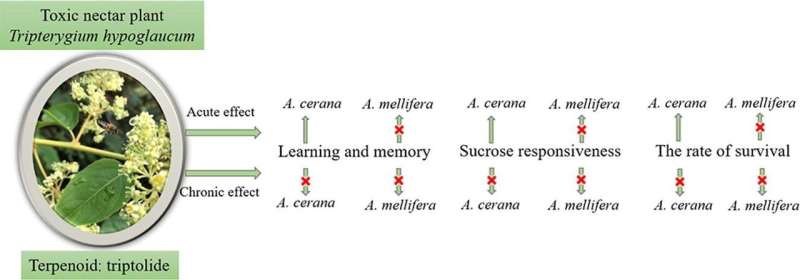Native Asian honeybees have higher toxin tolerance than introduced bees

The thunder god vine Tripterygium hypoglaucum is a toxic nectar plant distributed across China. A terpenoid, called triptolide (TRP), is found in the nectar of this plant and is likely toxic to the sympatric Asian honey bee, Apis cerana.
A. cerana and A. mellifera (European honey bee) are efficient pollinators that play an important role in biodiversity globally. Asian honey bees produce less honey and have weaker olfactory learning than European honey bees when fed pure sucrose syrup. To date, no studies have examined how triptolide may alter their learning and memory of different species, such as A. cerana and A. mellifera.
In a study published in the Journal of Insect Physiology, researchers from the Xishuangbanna Tropical Botanical Garden (XTBG) of the Chinese Academy of Sciences tested the tolerances of the native honeybee and the introduced honeybee to short-term and long-term exposure to triptolide.
The researchers compared three different aspects: consumption, survival rates, and learning and memory between A. cerana and A. mellifera before and after a short term and long term exposure to TRP laced sucrose solution in laboratory conditions.
They found that the introduced A. mellifera is more vulnerable in fatality to high concentrations of TRP sucrose solution than A. cerana. The olfactory learning of native Asian honey bees was not as good as European honey bees when they were associated with pure sucrose solution. However, when bees consumed the TRP laced food in a laboratory, their olfactory learning was impaired more in European honey bees than in Asian ones. This proved that the sympatric Asian honey bee was more TRP tolerant than introduced European honey bee.
Moreover, the Asian honey bees are more adaptive to mountainous areas, and benefit more from utilizing sporadic food resources. The researchers found no other larger or smaller size of native bee species other than A. cerana sympatric with the toxic plant T. hypoglaucum in temperate zone in the study.
"Our results support a coevolution hypothesis in that the native species A. cerana has higher toxin tolerance than the introduced species A. mellifera," said Tan Ken of XTBG.
More information: Junjun Zhang et al, Higher toxin tolerance to triptolide, a terpenoid foraged by a sympatric honeybee, Journal of Insect Physiology (2022). DOI: 10.1016/j.jinsphys.2022.104358
Provided by Chinese Academy of Sciences





















